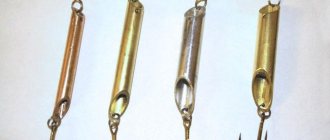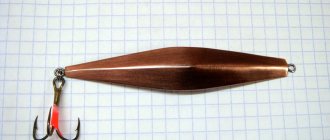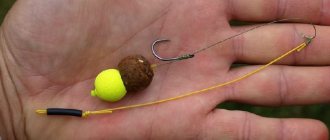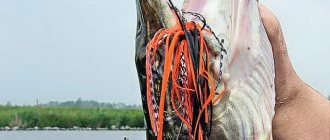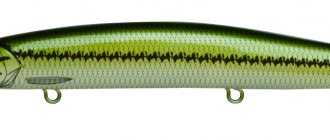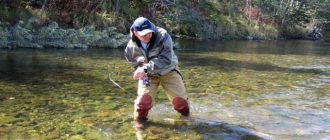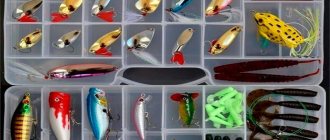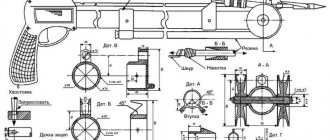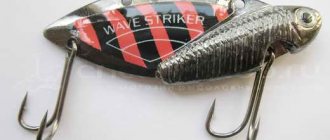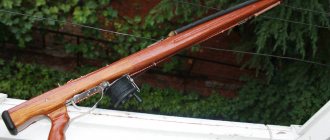Yuri 09/18/2020 810
Among the variety of artificial baits for fishing, amphipods occupy a special place. Its name is indirectly related to the amphipod crustacean. Fishermen nicknamed the artificial fish this way because of its specific location in the water. The jig also makes the same movements. The bait moves across the water area at a certain angle. Let's take a closer look at what amphipods are.
Origin of the species and description
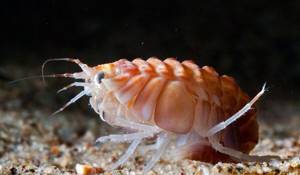
Photo: Amphipod
Amphipods (Amphipoda) are arthropods belonging to the class of higher crayfish in the order Amphipoda. This order was first described by the French entomologist Pierre Andre Latreille in 1817. This order includes more than 9,000 species of crustaceans. Amphipods are very ancient creatures; it is known that these crustaceans inhabited the benthos of seas and fresh water bodies at the beginning of the Stone period of the Paleozoic era, which is approximately 350 million years ago.
Video: Amphipod
However, due to the lack of carapace, the remains of these animals are almost not preserved; only 12 specimens of ancient crustaceans of this order are known. Fossils of ancient amphipods that lived during the Eocene period have been preserved. These fossils have survived to this day thanks to amber. An ancient animal fell into a drop of amber and could not get out of it, and only thanks to this circumstance can we know that these creatures lived during the Paleozoic era.
In 2013, an amphipod was described that lived in the Triassic period of the Mesozoic era, which is almost 200 million years older than the previous specimen. This amphipod of the species Rosagammarus minichiellus was described in the same year by a group of scientists led by Mark McMenamin. At the moment, the population of crustaceans is extremely diverse. This order also includes some planktonic organisms.
Amphipod fishing: fishing techniques and tactics
Winter fishing for predators with amphipods can be successful due to certain conditions, including the choice of fishing location and fishing technique. In winter, pike are usually found in places where the depth of the river and the turn change sharply, as well as in the rubble of snags. Fish are usually found in places where the oxygen concentration is maximum. In places with weak currents there are almost no predators. Closer to spring, predators come closer to the shore, to the place where melt water accumulates, where their food supply tends.
About
Appearance and description

Photo: What amphipod looks like
Amphipods are very small crustaceans. The size of an average individual is only about 10 mm in length, but large individuals measuring about 25 mm are also found, but rarely. Representatives of small species of amphipods are very tiny and their size is only 1 mm in length.
The body of amphipods is flattened on the sides. The main difference between amphipods and other crustaceans is the absence of carapace. On the chest, the anterior segment is completely fused with the head. The limbs on the first segment are represented by jaws. The limbs on the chest have a different structure. The front pair of limbs have large false claws. These claws are necessary for grasping food. The next two pairs end in claws. Only on the front claws are directed forward, and the rear claws are directed back.
Thanks to these claws, the animal can easily move along the subrostat. Between the 2nd and 7th thoracic segments there are gills. The belly of the amphipod is divided into several sections - the urosome and the pleosome. Each section includes 3 segments. On the pleosome segments there are pleopods, two-branched limbs used for swimming.
On the uresome there are uropod limbs, thanks to which the crustacean can jump high and move quite quickly along the shore and along the bottom of the reservoir. Urepods are quite strong. The excretory system is represented by the intestine and anus.
Types of amphipods
When choosing a model, it is important to pay attention to alignment. After tying to the fishing line, the front of the fisherman should be higher than the back.
For deep waters, choose a heavier bait than for shallow places. As for the size, here we must proceed from the object of fishing: the larger it is, the larger the bait should be. The size of an average amphipod is 4 cm. However, do not choose bait larger than 40 grams, as such fish play poorly.
We choose the color according to the following rule: at depth we use an artificial fish of a light shade, and in the shallows - a dark one. There is also an opinion among fishermen that when there is a strong minus, fish bite better on red bait, and in mild frost – yellow bait. Closer to zero, predators actively react to silver-colored spinners.
Fishing in the winter using amphipods is not only an active holiday, but also an opportunity to return home with a rich catch. An artificial fish lulls the predator's vigilance, arouses interest and provokes an attack.
Where does amphipod live?
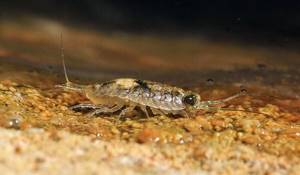
Photo: Amphipod in the river
Amphipods are extremely common creatures. They live in almost all freshwater bodies of water, seas, and at the bottom of the oceans. In addition, many amphipods also live in underground waters. They can be found in springs and wells in the Caucasus, Ukraine and western Europe.
The suborder Ingol-fiellidea lives in the underground waters of Africa, southern Europe and America. And also several species of these crustaceans live in the cappillar passages of sand on the shores of Peru, the English Channel and in the Gulf of Thailand. Species Gammarus pulex, G. kischinefensis, G. balcanicus. They inhabit the waters of England, Moldova, Germany and Romania. In our country, these crustaceans live in almost all bodies of water.
Marine amphipods live in the Azov, Black and Caspian Seas. Amphipods of several species live in the Volga, Oka and Kama rivers: Niphargoides sarsi, Dikerogammarus haemobaphes, Niphargoides sarsi. In the Yenisei and Angara reservoir there are more than 20 species of these crustaceans. Well, the most diverse fauna in Lake Baikal. 240 species of crustaceans live at the bottom of Lake Baikal. All crustaceans live at the bottom of reservoirs and lead a planktonic lifestyle.
Interesting fact: At the bottom of the Oka River, only in its lower reaches, there are about 170 thousand individuals of amphipods of the genus Corophium per square meter of bottom.
Now you know where amphipods are found. Let's find out what he eats.
Amphipod models
If we talk about store options, then we can highlight the following.
Amphipod "Wasp"

One of the most popular options, having an original shape and bright predatory coloring. Such baits are available in different sizes, weighing from 8 to 17 grams. The largest of them have increased resistance when playing, which makes their behavior completely unpredictable. And even with slow wiring, the “Wasp” is capable of performing real miracles. That is why it has practically no competitors in reservoirs with standing water and weak currents.
Amphipod "Classic"
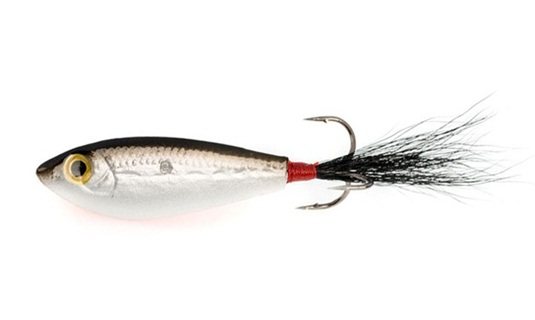
This bait is made in 3 weight varieties - 10, 15, 20, 25, 35 grams. A distinctive feature of lighter models is the ability to dive smoothly for a long time and make sweeping turns with simultaneous vibration. All this will not leave any predator indifferent. It has proven itself well on ponds, lakes and rivers with weak currents.
As for heavy universal amphipods - 25 and 35 grams, they are used at great depths, showing a bright game both directly under the hole and at a significant release. It is advisable to use it in areas with a moderate current, when caught in it, the bait, moving in short jerks, vibrates finely and tilts.
Universal amphipod
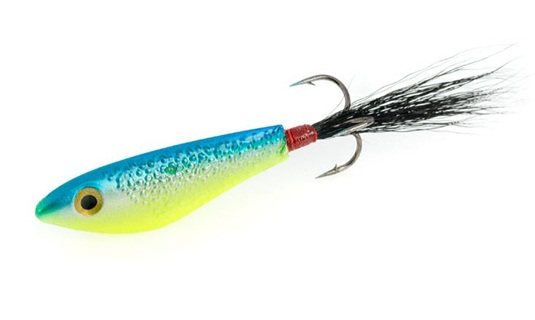
Here the name speaks for itself - the bait works in almost any conditions, a strong current will not be a hindrance for it. It is distinguished by a more compressed shape; when playing, it turns over on its side and makes a turn. Less active in the current, but in no way inferior in its effectiveness to other baits.
What do amphipods eat?
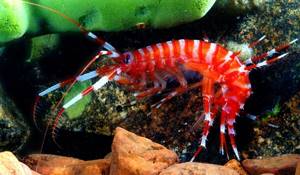
Photo: Amphipod crustacean
Almost all amphipods are omnivores.
The main diet of amphipods includes:
- underwater plants (both living parts and dead ones);
- remains of fish and other animals;
- priming;
- seaweed;
- small animals.
The method of eating may vary. These crustaceans bite off large food with their chews and break them into small pieces. Powerful jaws hold pieces of food, preventing it from falling out of the mouth. Some species of amphipods feed by filtering the suspension brought by the waves. These crustaceans usually live in the coastal zone. When they feel that the wave is moving away from the shore, the crayfish hide in the soil, only sticking out a little from it; when the soil is exposed, the crustaceans plunge into it entirely; this is how the species Niphargoides maeoticus usually feeds.
Crustaceans of the species Corophiidae, Leptocheirus and Ampeliscidae feed without leaving their homes. There these animals begin to muddy the top layer of soil with their rear antennas. Algae and bacteria enter the water, and the crayfish filters the water by passing it through a network of bristles located on its front legs. Predators among amphipods are sea goats.
These small crustaceans attack smaller relatives, worms, and jellyfish. Planktonic amphipods of the species Lysianassidae live on jellyfish and lead a semi-parasitic lifestyle. Parasitic species of amphipods Cyamidae whale lice. These small parasites settle on whales near the anus and feed on the skin of the whales, gnawing deep ulcers.
Amphipod installation
The spinner can be used in two ways: with the convex side up or down. Since the center of gravity in these cases will shift differently, the performance of the bait will also be different. Most often, the spinner is tied with the convex side up, since it will have the most effective action, making a large circle when swung and spinning when shaken. Experienced fishermen call this method of installation “according to active fish.”
The game “on passive fish” has less amplitude, but can also bring good results. The varieties of the game no less strongly depend on the method of tying the tee:
- a tee is attached to the end of the leash, the bait slides freely along the leash;
- A locking ring is placed at the end of the fishing line, the tee is located at the top between the swivel and the spoon.
After casting and releasing, the spoon first goes down, then the tee falls on it, which resembles a predator’s attack on a small fish and creates the preconditions for competition. The overwhelming majority of bites happen at this time. Without a tee, the spoon plays more aggressively, but the number of bites decreases, so with this method it is better to catch fish at the peak of its activity (at the beginning of ice formation and along the last ice).
How to tie an amphipod for winter fishing
Ways to tie a bait can be as follows:
- a round (classic) fishing line is inserted into the hole in the central part of the spoon, the tee is fixed;
- a corkscrew is placed on a round fishing line, then a tee and another corkscrew, the fishing line is wound through the amphipod and attached to the tee.

Amphipod equipment for winter fishing
Features of character and lifestyle
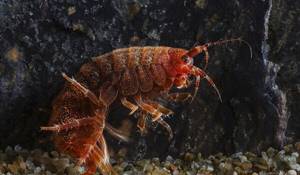
Photo: Amphipod
Most amphipods lead a semi-submersible lifestyle. During the day they live at the bottom of the reservoir, but at night these small crustaceans come out onto land and can crawl along the beach in search of food. They usually eat rotting algae that is washed ashore by the waves. During the daytime, the crustaceans return to the reservoir or hide in the soil, protecting their gills from drying out.
Like many crayfish, amphipods breathe with gills; the gill plates are permeated with thin vessels that retain moisture and this allows the crustaceans to escape to land. Crustaceans have an amazing ability to navigate in space; even when moving far away from the water, they can accurately determine where they need to return.
Some amphipods search for snags and branches, feeding on tree sawdust and dust. Predatory amphipods, sea goats, hide almost all the time among the thickets of grass. They track prey for a long time by sitting in one place with their front claws slightly raised, as soon as it sees the prey sharply and attacks it.
Whale lice lead a parasitic lifestyle and spend almost their entire lives on whales feeding on their skin. Small crustaceans living on the seabed lead a quiet lifestyle. Some practically never leave their burrows, feeding by filtering and constantly digging up the bottom.
Amphipod for perch
At moments when the striped predator does not bite, it is often the amphipod that comes to the rescue. A specific game interests the perch, provoking it to hunt.
The requirements for amphipods for perch fishing are not as stringent as for perch fishing. The predator reacts very actively to bright objects. Experienced fishermen know that perch are partial to red and copper colors. For additional attraction, accessories are suitable, for example, beads on a hook. Small amphipods with no dewlap are also produced for perch fishing.
Unlike pike perch, perch loves sharp and varied game. It bites well on aggressive shaking after a pause. The bait is usually completely enough.
All affected fish can be easily caught at the Sazanya Bay fishing base. To accurately determine the bite, we suggest looking at the Fisherman’s Calendar with the Catch Table, which will allow you to easily navigate which fish are biting by month.
TAGS:
Social structure and reproduction
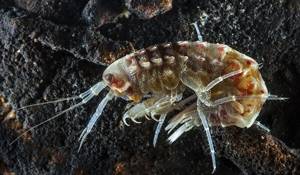
Photo: Crayfish amphipod
Amphipods are heterosexual creatures. Sexual dimorphism is often very pronounced. Depending on the species, males may be larger than females, or vice versa. In the family Gammaridae, males are many times larger than females. In the Leptocheirus family, on the contrary, females are larger than males. Sexually mature females of all amphipod species have a brood pouch.
Interesting fact: The development of male sexual characteristics in amphipods is due to the presence of a special hormone that is secreted by the androgenic endocrine glands. The transplantation of these glands into a female individual led to the degeneration of the female's ovaries into testes.
In the amphipod Gammarus duebeni, the sex of the offspring is determined by the temperature at which the eggs mature. In the cold season, males hatch; in the warm season, females are born. The mating process in amphipods lasts several days. The male presses against the female's back, holding the anterior and posterior edges of the female's fifth thoracic segment with his strong claws in anticipation of molting.
After molting, the male moves onto the female’s abdomen and puts his abdominal legs together, inserting them several times between the rear plates of the brood pouch. At this time, releasing sperm from the genital openings. With the help of the abdominal legs, sperm is transferred into the brood pouch. After 4 hours, the female lays eggs in this pouch and they are immediately fertilized. In different species of amphipods, the number of eggs that the female lays varies. In general, females lay from 5 to 100 eggs per mating.
But some species are more fertile, for example, Gammara-canthus loricatus lays up to 336 eggs, Amathillina spinosa up to 240. The most fertile White Sea amphipods Apopuh nugax after one mating, the female bears up to a thousand embryos. Amphipod embryos in the egg are curved towards the abdomen. From the moment of fertilization, It takes from 14 to 30 days before the small crustaceans leave the mother’s brood pouch.
Small crustaceans grow very quickly, surviving about 13 molts. Most species of amphipods reproduce in the warm season, but amphipods of the genus Anisogammarus carry eggs all winter, and by spring small crustaceans are born. The average lifespan of amphipods is about 2 years. Representatives of the species Niphargus orcinus virei live the longest; they can live up to 30 years, but on average they live about 6 years.
Tackle for amphipod fishing and its equipment
Any fishing rod for winter trolling is suitable as a fishing rod. It can be with or without a nod. This gear is very similar to a smaller copy of a spinning rod.
Most amphipods are made of tin or lead and are shaped like a small fish, usually with one convex side. The bait even has a tail made of a tuft of wool or feathers, which helps to camouflage the hook, and also gives it a realistic look and attracts fish.
Winter amphipods are usually larger, reaching 5-6 cm in length and weighing about 20 grams. For greater safety of the equipment, it is better to use a fluorocarbon leader than a regular monofilament line. This is necessary to prevent the fishing line from rubbing on the bait, otherwise the tackle can be damaged. The length of such a leash should be at least 20 cm, and the diameter should be about 3-4 mm.
A treble hook is also used to create gear for amphipods. The fishing line is passed through the amphipod's hole and attached to a ring with an additional tee, due to which the center of gravity shifts, and the amphipod works as a horizontal balancer.
Natural enemies of amphipods
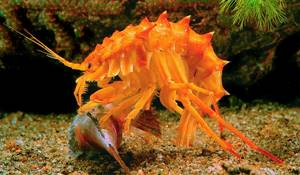
Photo: What amphipod looks like
The main enemies of amphipods are:
- fish;
- whales and killer whales;
- turtles;
- minks;
- cats;
- dogs;
- muskrats;
- frogs and other amphibians;
- insects and their larvae;
- arachnids;
- birds (mainly sandpipers).
Amphipods are very small and almost defenseless creatures. Therefore, in their natural environment, these crustaceans have plenty of enemies. Because of this, crustaceans try to lead a more or less secretive lifestyle. In rivers, amphipods are hunted by eels, burbot, perches, roaches, bream and many other fish. Eels are considered the most dangerous enemies of these crustaceans, since these fish constantly dig the ground and easily climb into crayfish burrows.
Birds and mammalian predators lie in wait for crayfish on the shore. But most amphipods die not from falling into the clutches of predators, but from disease. And the most dangerous of them is the crayfish plague. It is the plague that destroys thousands of crustaceans every year. Crustaceans also suffer from parasitic diseases; even these small creatures are inhabited by parasites. The most vulnerable crustaceans are those that have received any kind of injury; various bacteria quickly multiply on the wounds.
Pollution of water bodies is also an unfavorable factor. Amphipods are very sensitive to the ingress of harmful substances into water; there are known cases of mass death of these crustaceans in places where water bodies are heavily polluted.
What is amphipod?
Amphipod is a spinner that is used for vertical fishing during winter fishing from ice. This bait appeared a long time ago and was known to fishermen even before the appearance of balancers. This type of artificial spoon should not be confused with crustacean or jig; they have nothing in common with each other.
Photo: amphipods Lucky John Ossa
The spinner received this name because of its imitation of a fish and its characteristic game during the retrieve. The amphipod moves in the horizontal plane of the water, and thanks to its unusual shape, it seems that it is moving sideways. If you prepare the tackle correctly, when the spoon is attached under an oblique suspension to the main fishing line, then no other winter bait will give such a result as amphipod. It has the following properties:
- The amphipod performs circular movements when swinging the fishing rod, imitating the movements of a fry trying to escape from a predator.
- Circulates around the main line when fishing by jig fishing.
- The amphipod carries out characteristic movements in the horizontal plane due to the shifted center of gravity and the specific shape of the bait.
- The spoon is effective both for catching passive fish and active perches.
A little about buying and harvesting mormysh
The main places where amphipods are sold are pet stores. Here it is purchased not only by fishermen, but also by owners of aquarium fish, who call this crustacean creature gammarus.
In order to save money or if mormysh is not available for sale, you can start harvesting it yourself. To do this, you will have to go to the nearest river, lake or pond. In warm months, amphipods live in those parts of the reservoir where the water remains cool and at the same time rich in oxygen, so you need to look for it near snags and closer to the bottom. With the onset of frost, the mormysh changes its habitat, rushing closer to the surface. It requires oxygen, so it can cling to ice.
The basis of the crustacean's diet is rotting aquatic thickets. In this regard, as a tool for its extraction, use straw or spruce branches that need to be lowered into the pond. After a certain time, take them out and start collecting the caught amphipods. Coniferous branches or straw can be replaced with a bag. It should be tied to a stick and thus lowered into the water. After this, they need to be led several times in different directions. In a few minutes, a lot of crustaceans will have time to grab onto the burlap, so all you have to do is take the bag out and collect them.
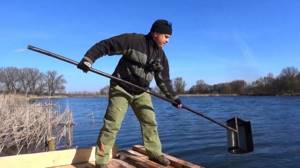
If you are going to catch mormysh in the winter months, then you should take into account a number of features. The most important thing is that it is most convenient to catch amphipods in severe frosts, when it is possible to collect them from the ice. To solve this problem, you will need to saw through the hole. To make the process of collecting mormysh more convenient, use a special hoop with a mesh as a scraper or a device that many call a dredge or a combine.

Pike for amphipods: features of fishing from ice
Amphipod bait is most often used for winter fishing, but it can also be used for fishing in open water. Amphipods were originally invented for catching pike perch in the winter, but other predators, including pike, also bite on the bait. This bait can also be used for fishing perch and bersh from the ice. Compared to the balancer, the amphipod has more opportunities for catching nimble fish. Catching pike with amphipods can be quite troublesome, since the toothy predator often injures fishing lines after repeated hookings. The lateral tilt when playing an amphipod has a fascinating effect on the pike, since its slow play and circular movements are much more attractive to the pike than the work of other balancers. In the process of catching pike, it quite often cuts off amphipods, especially dark ones, since in appearance they resemble the fish that the predator hunts.
To catch pike from ice, large amphipods up to 7 mm thick are most often used. If a fish is caught on the back tee, then when hooked, the metal leader begins to deform exactly in the place where the bait is equipped with a hole. If this situation is repeated repeatedly, then soon the fishing line becomes unusable, and this will lead to the loss of fish and even the amphipod itself, since the deformed parts change the suspension and worsen the performance of the bait.
When catching large fish like pike, experienced fishermen recommend pre-drilling the hole in the amphipod, due to which the suspension will suffer less.
Amphipod for winter fishing
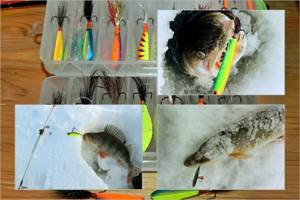
In winter fishing, the Amphipod (Osa) spinner is more often used for catching pike perch and pike. Sometimes burbot is caught and large perch are caught. Amphipods for perch are also used in the form of a jig of the same name.
Amphipod shape and color

The amphipod is made of metal, most often cast from tin and lead. In shape it resembles a fish, one of the sides of which is more convex. Hooks decorated with plumage or a tuft of goat hair are mounted in the tail of the bait. During installation, an additional triple hook is used.
Winter amphipod is most often a bait 4-6 cm long and weighing up to 20 grams. There are light models for fishing in shallow water and heavier ones for fishing in deep water and in the presence of currents. The heaviest Wasps are used for vertical fishing from a boat during the summer fishing season.
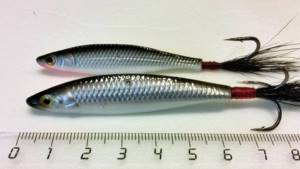
Amphipod "Tyulka"
The color of the amphipod does not play the first role, but it is also important. Amphipod for pike perch is most often a light-colored bait similar in color to the color of the fish that are the target of pike perch.
There is no strictly defined and generally accepted classification of amphipods by species. Therefore, we divide them according to types conditionally.
Varieties of amphipods:
- Classic symmetrical;
- Asymmetric amphipod (Wasp).
Any fisherman or manufacturer can apply their own classification and names of these baits.
Amphipod catchability
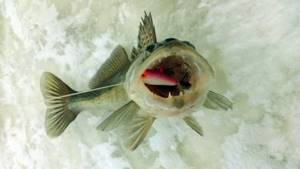
In the hands of an experienced fisherman, he can “throw” a balance beam and any other bait into his belt to catch a predator. The catchability of an amphipod is determined by two things:
- The ability of the amphipod to produce the desired game for the fish;
- The ability of the fisherman to give the bait the correct action.
Not every amphipod that is on sale or made with your own hands will be catchy, however, like, for example, a balancer and a vertical spoon. Only half of the baits from the counter, after being tested on the pond, are sent to the workers. But the right amphipod, in terms of catchability, may be the only bait “that will bite today.”
Amphipod game - wiring
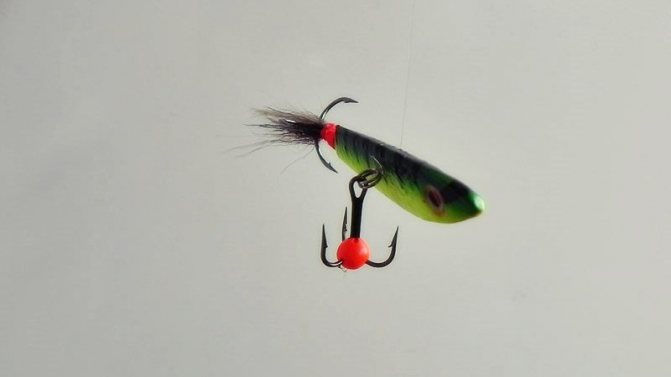
The amphipod has a unique game - unlike the balancer that describes the figure eight, its game is more varied. The wasp walks in a circle or along a curve, draws spirals, figure eights, can “dance” on its tail and roll from side to side.
However, the amphipod itself does not play; this game is given to it by the fisherman, and for this you need to know the wiring options. If the game of balancing (toss - pause) can be mastered immediately by any beginner, fishing with a wasp is more variable and will require more experience and skills.
Options for playing amphipods:
- Balanced - (toss - pause - toss) the bait moves in a figure eight or in a spiral;
- Jig - swinging the bait, the amphipod stands on its tail, turning around its axis, “dancing”;
- Smooth rise, dropping to the bottom with a step.
sea flea
An incredible number of animals can be found in Anapa, not only under water, but also under stone pebbles and even deep in the coastal sand. Raking small pebbles with their hands, many have more than once noticed the life teeming beneath them. The most noticeable and by no means useless creatures will happily jump and fuss if you lift any stone on the beach. Meet these amphipods, an integral part of the wildlife of the Black Sea coast, which forms the basis of the diet of most fish and crabs. Let's take a closer look at them.
Appearance
Amphipod crustaceans are multi-legged crustaceans, and this can be easily verified by looking at the limbs of our inhabitant. The structure of each pair of crustacean legs is different and serves for a variety of purposes; we can say that the legs of an amphipod are one universal folding knife. The first pair with pseudo claws is designed for holding and crushing food, the next pair of legs is adapted for swimming, the other legs are for running, and where would we be without legs for jumping. It is difficult to notice such a metamorphosis in the structure, because amphipods in Anapa reach a size of 5 - 10 millimeters. For a good inspection you will need a magnifying glass or microscope. Another feature of the microcrustacean is the absence of a main shell, a shield protecting the body from above; all the protection of the amphipod is soft segments. The body of the crustacean is hunched and compressed from the sides to make it easier to get between the stones. In Anapa you can find amphipods with gray and brown tints; their protective colors help protect them from predators. The lifespan of a small animal is one to two years.
Habits
The short life of the amphipod pushes the crustacean towards active reproduction. A variety of local crustaceans has female and male representatives of the genus. As soon as the water temperature allows mating games to begin, the amphipods actively mate, and the couple can swim for a day, merging in ecstasy. At this time, the male transfers his seed to the bride into a special bag, where the eggs develop. It is in this same pouch that babies grow up and leave their mother’s womb after the first molt. Local amphipods are beach nurses whose favorite food is animal corpses and rotting algae. Feeding and other active life of the crustacean begins at night. During the daytime, the sea is teeming with predators who are not averse to eating crustaceans, so at this time it is better to sit out in the ground or under pebbles.
Interesting Facts
Scientists who study the life of amphipods have discovered the unique ability of these tiny animals to navigate by light. Crayfish have a well-developed “biological clock”; they know when day turns to night, based on the direction and intensity of light. Remembering in which direction the salt lick shines from the shore, amphipods begin their movement towards the water. Researchers have discovered an interesting feature of sex distribution in young crustaceans. Experiments have shown that the sex of the new amphipod offspring closely depends on the water temperature in Anapa. If the fry develop in cooler water, then male amphipods are born; if the water is warmer than normal, expect females. In Anapa, locals call amphipods sea fleas. This name stuck to the harmless creatures because of their ability to jump. Sensing danger, small crustaceans begin to sharply contract and push off the ground with their paws, performing rapid acceleration. For tourists who vacation in Anapa, these flights reminded the life of an earthly bloodsucker, but amphipods are absolutely harmless to humans.
Where to see in Anapa.
The method for detecting amphipods on the beach is very simple. On the pebble beach of Anapa, you need to find a bunch of old algae. Having lifted the soft remains, the worried amphipods will immediately begin to rush and jump, sensing danger, because the day for the amphipods is a time of rest. Usually the small crustacean is used for bait when fishing, not Black Sea fish.
Technique for guiding amphipods

The wiring of this bait is based on the 8x8 technique. This is a process of eight strokes, followed by pauses of eight seconds. It looks something like this:
- The bait is lowered into the hole and placed at a distance of 15-20 cm from the bottom.
- After this, the bait smoothly rises to a height of 50 cm, after which the movement stops and the fishing rod sharply returns to its original position.
- Having placed the fishing rod in its original position, wait about 8 seconds, after which the movement is repeated. There should be no more than eight movements, since everything further is pointless, as practice shows.
Catching pike perch with amphipods. How to play amphipod.
If there is a predator next to the hole, then it will definitely try to attack the bait. At the same time, the bite may not be as powerful as sometimes expected. If there was a bite, then you can continue to stay near this hole and play with bait. In this case, you should show persistence and patience.
